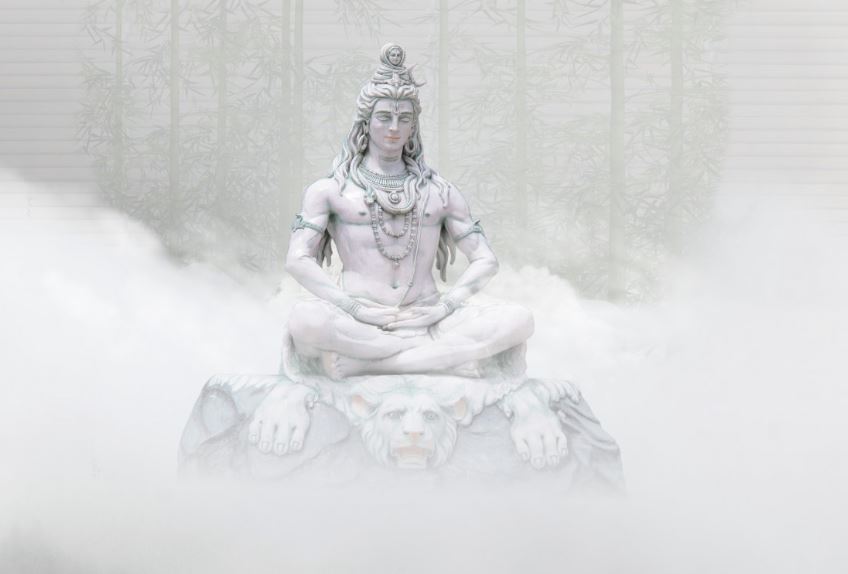“Of all Yogis, he who always abides in Me with great faith, worshiping Me in transcendental devotional service, is most intimately united with Me in Yoga and is the highest Yogi of all.” Bhagavan Sri Krishna, Bhagavad Gita, 6:47
Devotion to the Absolute
The central message of the Bhagavad Gita, the most important scripture in all of Sanatana Dharma, is that bhakti, or devotion to the Absolute, constitutes the most effective and highly recommended path in all of the Yoga tradition. It is truly unfortunate, however, that despite the almost universally held importance of bhakti in the history of Yoga, there seems to have always been a good deal of misunderstanding on the part of many about what the terms “bhakti” and “Bhakti Yoga” actually mean. I’ve read even many supposedly knowledgeable authors write that bhakti is the Yoga of “emotion”, or that it somehow precludes any involvement with jnana (knowledge, or intellectualism), philosophy, or serious Yogic sadhana (practice). Nothing could be further from the truth.
The word “bhakti” is derived from the Sanskrit verb root `bhaj’, meaning “to share in, resort to, experience, partake of, cultivate, worship, go to”, etc. The object of this “experiencing” or “partaking in” is, of course, God. In this definition, we can begin to recognize in seed form what the foundational basis of Bhakti Yoga consists of.
Bhakti is a trans-emotional state of consciousness that we are meant to cultivate and uncover as the natural essence of our soul, and Bhakti Yoga is a complex and rigorous system of Yoga designed to bring its adherent to a progressively deeper state of meditative absorption (samadhi) in the Divine. Thus, the term “bhakti” denotes both a state of trans-empirical perceptual awareness and phenomenological experience, as well as a philosophical system and praxis designed to bring about such a higher state of awareness of the Divine.
Bhakti is meditation in its fullest and deepest manifestation.
Bhakti actually denotes devotional meditative absorption. Unlike any other system of Yoga, bhakti stands apart from all other systems in that it actually constitutes both a means (upaya) toward the goal of God-realization (and thus it is a Yoga), as well as the end (artha) of Yoga itself in the form of a spiritual state of pure egolessness and God-consciousness. Bhakti is not only the most effective and most highly recommended means of enlightenment, but bhakti IS enlightenment.
“Devotion” in this correctly understood bhakti sense is radically different from “emotion”. Bhakti is a state of consciousness that is transcendent in essence and which reflects the innermost, latent nature of the atman (true self) as being functionally contingent and ontologically sustained by the Absolute. Bhakti, or devotion in this more phenomenological sense, represents the true functional nature of our soul. There is nothing material, or emotional, or sentimental about bhakti at all.
Emotion, on the other hand, is held universally by all the schools of Yoga and Dharmic spirituality, to be a purely material-originated phenomenon that arises from manas (mind), chitta (psyche), desire (kama) and anger (krodha). Thus, materially-inspired emotions are unreal, temporary and negative in the truest, spiritual sense. Emotions that stem from materialistic likes and dislikes are akin to phantasms that while certainly experienced in a very real way when we have them are nonetheless not of lasting importance. This is especially true of negative emotions that arise from our illusion of being separate from God.
Material emotions, for the yogi, are to be transcended. Devotion, for the yogi, is to be cultivated.
This being said, Sanatana Dharma does not teach that emotions are inherently evil or unwanted instruments. Emotions in and of themselves are actually a neutral tool. They are a tool that can be used for either good or for self-bondage. An emotive mechanism is just as much a neutral tool as is our mind, body, intellect, etc. Just as is true of our mind, body, and intellect, it isn’t that any of these tools are inherently either good or bad. Rather, they’re good if they are under our control, and bad if they’re not under our control.
When a person has an uncontrolled mind, they’re considered to be mentally disturbed. When a person has an uncontrollable body, then they’re experiencing some sort of physical illness. In the same way, when a person has emotions that are uncontrolled, they tend to be emotionally unstable and thus unpeaceful. And peace is the direct manifest symptom of spiritual transcendence.
 To have normal, reactive emotions toward things that happen in our lives is natural. Emotions arise as a result of external things that affect us, which we then perceive as either good or bad. Just like if someone hits us, we feel physical pain, in the same way, if someone hurts us emotionally, we then feel emotional pain. Emotions are a natural effect to external stimuli or at least to our perceptions of such stimuli.
To have normal, reactive emotions toward things that happen in our lives is natural. Emotions arise as a result of external things that affect us, which we then perceive as either good or bad. Just like if someone hits us, we feel physical pain, in the same way, if someone hurts us emotionally, we then feel emotional pain. Emotions are a natural effect to external stimuli or at least to our perceptions of such stimuli.
But if we were to cry for the next week because we gently stubbed our toe, then we would be overreacting to a very minuscule amount of physical pain, and we wouldn’t really be in control of our physical reactions. In the same way, if we overreact and give in to a sea of uncontrollable emotion with every incident that happens to us, big and small, then we are not serving ourselves, but rather being slaves of our uncontrolled emotions.
So the idea that is espoused in Yoga spirituality is not to artificially repress, ignore, or stifle our emotions, mind, intellect, ego, body, etc., but to see them in their proper place in relation to spirit, our true self, and to then control and thus transcend their power over us. It is a simple matter of having
control over our emotions, rather than allowing our emotions to have control over us.
A prevalent misconception that many have is that God-realized, or enlightened, people are necessarily emotionless people because they have learned to transcend emotion. Nothing could be further from the truth. God-realized people are certainly not emotionless. On the contrary! They can be the most fun people to be with. God-realized sages can laugh, can cry, and can even exhibit anger when appropriate. God-realized people can be emotional; but such emotion tend to be positive emotions that are used in God’s service, as well as spiritual bhava, or transcendent states of consciousness that the unwise might mistakenly confuse with material emotions. God-realized persons: 1) try not to be ruled by their emotions; 2) tend to focus on more positive emotions (love, compassion, pity, joy, etc.); 3) and ultimately the emotive states that they experience most deeply are
the transcendental mellows of love between themselves and God, and not the lower, reactive emotions that arise from sense perception.
In the highest state of Self-realization and God-realization, our material emotions are keenly surpassed and are subsequently replaced by devotional ecstasy and states of rapturous spiritual elations the likes of which nothing in our present perceptual state can comprehend. To experience such bliss, we must practice Bhakti Yoga, the Yoga of devotion. The greatest textbook on Bhakti Yoga is the Bhagavad Gita. Beginning with a devoted study of the Bhagavad Gita, coupled with daily meditation upon the Absolute under the expert guidance of an authentic spiritual teacher (guru), we can know the bliss of love of God.






